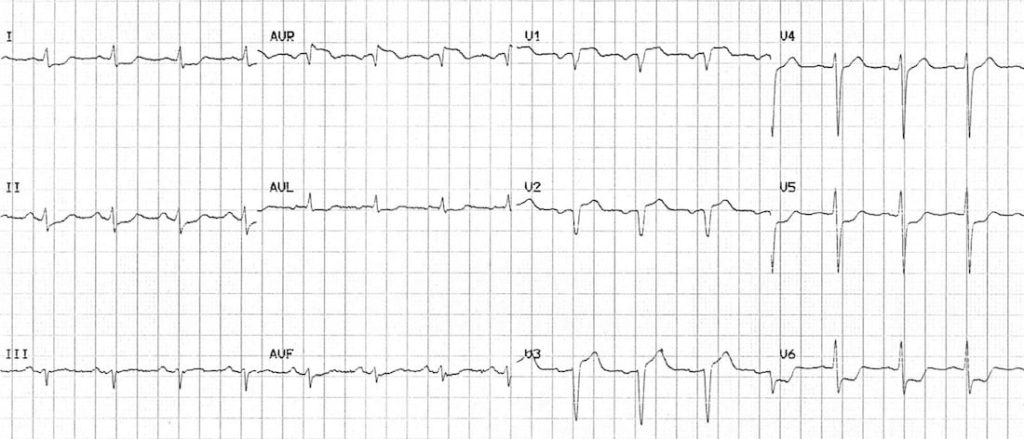ECG Case 068
Severe chest pain and hypotension (70/40) in an elderly man. Describe and interpret his ECG

Describe and interpret this ECG
ECG ANSWER and INTERPRETATION
This ECG shows:
- ST elevation in aVR.
- ST depression in multiple leads (V5-6, I, II, aVL, aVF).
- Evidence of anteroseptal STEMI – ST elevation with Q wave formation in V1-3.
In the context of ischaemic chest pain and cardiogenic shock, the combination of…
- Widespread ST depression
- ST elevation in aVR > 1 mm
- ST elevation in V1-3
… is concerning for proximal LAD occlusion (compare this to the LMCA pattern seen in Quiz ECG 008).
While this pattern of diffuse ST depression with STE in aVR if often referenced as a marker of LMCA / proximal LAD occlusion, may be seen whenever there is diffuse severe subendocardial ischaemia, such as:
- Severe triple vessel disease
- Severe anaemia or hypoxaemia
- Following resuscitation from cardiac arrest
OUTCOME
This patient actually had severe multi-vessel disease.
Angiography demonstrated a chronic total occlusion of his circumflex artery, with critical stenoses of his proximal LAD, RCA and ramus intermedius.
Surprisingly, in this case the culprit vessel was thought to be the RCA, which had been collateralising his chronically occluded circumflex. He went on to receive a CABG x 4.
References
Further Reading
- Wiesbauer F, Kühn P. ECG Mastery: Yellow Belt online course. Understand ECG basics. Medmastery
- Wiesbauer F, Kühn P. ECG Mastery: Blue Belt online course: Become an ECG expert. Medmastery
- Kühn P, Houghton A. ECG Mastery: Black Belt Workshop. Advanced ECG interpretation. Medmastery
- Rawshani A. Clinical ECG Interpretation ECG Waves
- Smith SW. Dr Smith’s ECG blog.
- Wiesbauer F. Little Black Book of ECG Secrets. Medmastery PDF
TOP 100 ECG Series
Emergency Physician in Prehospital and Retrieval Medicine in Sydney, Australia. He has a passion for ECG interpretation and medical education | ECG Library |
